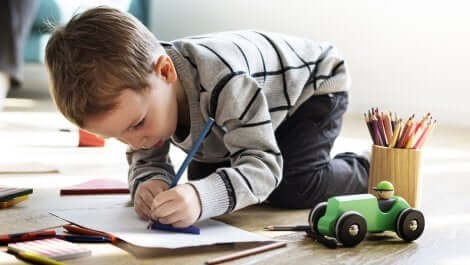Drawing Tests: Learn About Your Child Through Drawings


Written and verified by the psychologist Elena Sanz Martín
Drawing tests are a great tool to psychologically evaluate children. Through their drawings, we can access the unconscious minds of kids in a simple and fun way. In addition, this approach avoids barriers or resistance that could arise when trying to assess children in more direct ways.
These tests allow us access very valuable information about children’s personalities and problems. In drawings, they project what they carry inside. They draw what they feel more than what they see.
What are drawing tests?
Drawing tests are part of projective techniques that study personality through unstructured materials that we offer to the child. In fact, this lack of structure lets them recreate their experiences freely.

In graphic techniques, specifically, the child is instructed to draw certain things. By analyzing the symbolism of their drawings, we can see their wants, conflicts and fears. Also, we can see social or family problems, as well as development difficulties.
Although these types of tests can also be applied to adults, they’re especially good for child evaluation. For kids, drawing is a daily and fun activity. In addition, it’s hard for some kids to express themselves verbally when they’re so young.
What should we look at in drawing tests?
To draw conclusions, it’s important to look at standardized manuals and have extensive clinical experience working with these tests. However, these are some things to take into account when looking at drawing tests:
- Curious elements that attract the naked eye. Parts of the drawing that should be there but aren’t, as well as additional things. For example, a person without a nose or with three ears. This could alert us that there’s a conflict related to that element.
- Deleted or crossed out sections. Making too many corrections can show a tendency of perfectionism.
- Shading in some part of the drawing might mean they’re expressing a certain fixation or anxiety about the shaded area.
- Pencil strokes. A strong and dark line indicates security and firmness while weak strokes could mean shyness or insecurity.
- Location of the drawing. The place on the paper where they draw can show us their degree of imagination or realism. The lower the drawing, the more attached to reality they are.
Examples of drawing tests
The draw-a-person test
In this technique, the child has to draw a person. At the end, you ask them to draw another person of the opposite sex. These drawings make it possible to determine both the child’s mental maturity and the presence of emotional problems.

The indicators more related to intellectual difficulties are: tiny figures, very large head or omitting feet and hands. Those that can indicate emotional difficulties would be: large hands or feet, prominent teeth and nails or shading the body.
The family test
In this technique, the child draws a family. From the drawing, we can infer how the child perceives family ties. For example, what they draw first and put in the middle are what the child thinks are most important. Also, the images that are larger and drawn with more details are also important to them.
On the contrary, the figures that are drawn last, smaller and with less detail, aren’t as important to the child. On the other hand, the closer two figures are located in the drawing, the greater the emotional ties between them.
Conclusions
There is some controversy about the reliability and validity of these tests. It’s important to use reliable sources to avoid interpreting them in a subjective way. However, they’re a great tool to look into a child’s inner world in an easy and accessible way for them.
Through these tests, we can detect both intellectual and emotional difficulties. Above all, we can learn more about children’s personalities and their way of seeing themselves and their environment.
Drawing tests are a great tool to psychologically evaluate children. Through their drawings, we can access the unconscious minds of kids in a simple and fun way. In addition, this approach avoids barriers or resistance that could arise when trying to assess children in more direct ways.
These tests allow us access very valuable information about children’s personalities and problems. In drawings, they project what they carry inside. They draw what they feel more than what they see.
What are drawing tests?
Drawing tests are part of projective techniques that study personality through unstructured materials that we offer to the child. In fact, this lack of structure lets them recreate their experiences freely.

In graphic techniques, specifically, the child is instructed to draw certain things. By analyzing the symbolism of their drawings, we can see their wants, conflicts and fears. Also, we can see social or family problems, as well as development difficulties.
Although these types of tests can also be applied to adults, they’re especially good for child evaluation. For kids, drawing is a daily and fun activity. In addition, it’s hard for some kids to express themselves verbally when they’re so young.
What should we look at in drawing tests?
To draw conclusions, it’s important to look at standardized manuals and have extensive clinical experience working with these tests. However, these are some things to take into account when looking at drawing tests:
- Curious elements that attract the naked eye. Parts of the drawing that should be there but aren’t, as well as additional things. For example, a person without a nose or with three ears. This could alert us that there’s a conflict related to that element.
- Deleted or crossed out sections. Making too many corrections can show a tendency of perfectionism.
- Shading in some part of the drawing might mean they’re expressing a certain fixation or anxiety about the shaded area.
- Pencil strokes. A strong and dark line indicates security and firmness while weak strokes could mean shyness or insecurity.
- Location of the drawing. The place on the paper where they draw can show us their degree of imagination or realism. The lower the drawing, the more attached to reality they are.
Examples of drawing tests
The draw-a-person test
In this technique, the child has to draw a person. At the end, you ask them to draw another person of the opposite sex. These drawings make it possible to determine both the child’s mental maturity and the presence of emotional problems.

The indicators more related to intellectual difficulties are: tiny figures, very large head or omitting feet and hands. Those that can indicate emotional difficulties would be: large hands or feet, prominent teeth and nails or shading the body.
The family test
In this technique, the child draws a family. From the drawing, we can infer how the child perceives family ties. For example, what they draw first and put in the middle are what the child thinks are most important. Also, the images that are larger and drawn with more details are also important to them.
On the contrary, the figures that are drawn last, smaller and with less detail, aren’t as important to the child. On the other hand, the closer two figures are located in the drawing, the greater the emotional ties between them.
Conclusions
There is some controversy about the reliability and validity of these tests. It’s important to use reliable sources to avoid interpreting them in a subjective way. However, they’re a great tool to look into a child’s inner world in an easy and accessible way for them.
Through these tests, we can detect both intellectual and emotional difficulties. Above all, we can learn more about children’s personalities and their way of seeing themselves and their environment.
All cited sources were thoroughly reviewed by our team to ensure their quality, reliability, currency, and validity. The bibliography of this article was considered reliable and of academic or scientific accuracy.
- Maganto Mateo, C., & Garaigordobil Landazabal, M. (2009). El diagnóstico infantil desde la expresión gráfica: el test de Dos Figuras Humanas (T2F). Clínica y Salud, 20(3), 237-248.
- Corman, L. (1967). El test del dibujo de la familia. Buenos Aires: Kapelusz.
This text is provided for informational purposes only and does not replace consultation with a professional. If in doubt, consult your specialist.








